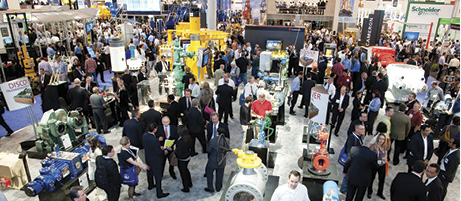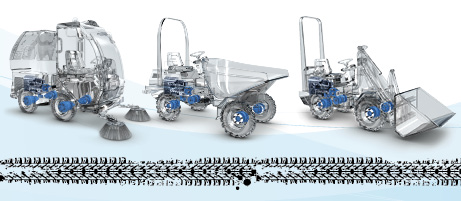Hydraulic Pumps and Motors: Considering Efficiency
In a condition-based maintenance environment, the decision to change out a hydraulic pump or motor is usually based on either remaining bearing life or deteriorating efficiency, whichever occurs first.
Despite recent advances in predictive-maintenance technologies, the maintenance professional’s ability to determine the remaining bearing life of a pump or motor with a high degree of accuracy remains elusive.
Deteriorating efficiency, on the other hand, is easy to detect because it typically shows itself through increased cycle times. In other words, the machine slows down. When this occurs, quantification of the efficiency loss is not always necessary. Reason being, if the machine slows to the point where its cycle time is unacceptably slow, the pump or motor is changed out. End of story.
In certain situations, however, it can be helpful, even necessary, to quantify the pump or motor’s actual efficiency and compare it to the component’s native efficiency. And for this, an understanding of hydraulic pump and motor efficiency ratings is essential.
There are three categories of efficiency used to describe hydraulic pumps (and motors): volumetric efficiency, mechanical/hydraulic efficiency, and overall efficiency.
Volumetric efficiency is determined by dividing the actual flow delivered by a pump at a given pressure by its theoretical flow. Theoretical flow is calculated by multiplying the pump’s displacement per revolution by its driven speed. So if the pump has a displacement of 100 cc/rev and is being driven at 1,000 rpm, its theoretical flow is 100 liters/minute.
Actual flow has to be measured using a flowmeter. If when tested, the above pump had an actual flow of 90 liters/minute at 207 bar (3,000 psi), we can say the pump has a volumetric efficiency of 90% at 207 bar (90 / 100 x 100 = 90%).
Volumetric efficiency is what we use most in the field to determine the condition of a hydraulic pump based on its increase in internal leakage through wear or damage. But without reference to theoretical flow, the actual flow measured by the flowmeter would be meaningless.
A pump’s mechanical/hydraulic efficiency is determined by dividing the theoretical torque required to drive it by the actual torque required to drive it. A mechanical/hydraulic efficiency of 100% would mean if the pump was delivering flow at zero pressure, no force or torque would be required to drive it. Intuitively, we know this is not possible due to mechanical and fluid friction.
Like theoretical flow, theoretical drive torque can be calculated. For the above pump, in SI units: 100 cc/rev x 207 bar / 20 x π = 329 Newton meters. But like actual flow, actual drive torque must be measured, and this requires the use of a dynamometer. Not something we can—or need—to do in the field. For the purposes of this example, though, let’s assume the actual drive torque was 360 Nm. Mechanical/hydraulic efficiency would be 91% (329 / 360 x 100 = 91%).
Overall efficiency is simply the product of volumetric and mechanical/hydraulic efficiency. So continuing with the above example, the overall efficiency of the pump is 0.9 x 0.91 x 100 = 82%. Typical overall efficiencies for different types of hydraulic pumps are shown in Table 1.
System designers use the pump manufacturers’ volumetric efficiency value to calculate the actual flow a pump of a given displacement, operating at a particular pressure, will deliver. And as already mentioned, volumetric efficiency is also used in the field to assess the condition of a pump based on increase in internal leakage due to wear or damage.
For example:
Consider a variable-displacement pump with a maximum flow rate of 100 liters/minute. If it was flow tested at full displacement and the measured flow rate was 90 liters/minute, the calculated volumetric efficiency would be 90% (90/100 x 100). But if the same pump was flow tested at the same pressure and oil temperature but at half displacement (50 L/min), the leakage losses would still be 10 liters/minute and so the calculated volumetric efficiency would be 80% (40/50 x 100).
The second calculation is not actually wrong, but it requires qualification: this pump is 80% efficient at half displacement. Because the leakage losses of 10 liters/minute are nearly constant, the same pump tested under the same conditions will be 90% efficient at 100% displacement (100 L/min)—and 0% efficient at 10% displacement (10 L/min)!
When calculating volumetric efficiency based on actual flow testing, it’s important to be mindful of the fact that the various leakage paths within the pump are usually constant. This means if pump flow is tested at less than full displacement (or maximum RPM), this will skew the calculated efficiency—unless leakage is treated as a constant and necessary adjustment made.
To help understand why pump leakage at a given pressure and temperature is almost constant, think of the various leakage paths as fixed orifices. The rate of flow through an orifice is dependant on the diameter (and shape) of the orifice, the pressure drop across it, and fluid viscosity. This means that if these variables remain constant, the rate of internal leakage remains constant, independent of the pump’s displacement or shaft speed.
Overall efficiency is used to calculate the drive power required by a pump at a given flow and pressure. For example, using the overall efficiencies from the table above, let us calculate, in SI units, the required drive power for an external gear pump and a bent axis piston pump at a flow of 90 liters/minute at 207 bar:
- External gear pump: 90 x 207 / 600 x 0.85 = 36.5 kW
- Bent axis piston pump: 90 x 207 / 600 x 0.92 = 33.75 kW
As you’d expect, the more efficient pump requires less drive power for the same output flow and pressure. With a little more math, we can quickly calculate the heat load of each pump:
- Drive power for a (non-existent) 100% efficient pump would be: 90 x 207 / 600 x 1 = 31.05 kW.
So at this flow and pressure, the heat load or power lost to heat of each pump is
- External gear pump: 36.5 – 31.05 = 5.5 kW
- Bent axis piston pump: 33.75 – 31.05 = 2.7 kW
No surprise then that a system with gear pumps and motors requires a bigger heat exchanger than an equivalent (all other things equal) system with piston pumps and motors.
About the Author
Brendan Casey is the founder of HydraulicSupermarket.com and the author of Insider Secrets to Hydraulics, Preventing Hydraulic Failures, Hydraulics Made Easy, Advanced Hydraulic Control, and The Definitive Guide to Hydraulic Troubleshooting. A fluid power specialist with an MBA, he has more than 20 years experience in the design, maintenance and repair of mobile and industrial hydraulic equipment. Visit his website: www.HydraulicSupermarket.com.










One thought on “Hydraulic Pumps and Motors: Considering Efficiency”